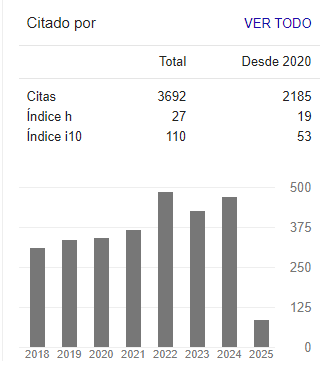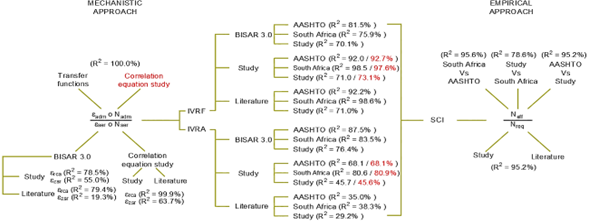
DOI:
https://doi.org/10.14483/23448393.22420Published:
2025-04-15Issue:
Vol. 30 No. 1 (2025): January-AprilSection:
Civil and Environmental EngineeringStructural Assessment of Flexible Pavements Based on the Level of Detail of Management Functions
Evaluación estructural de pavimentos flexibles basada en el nivel de detalle de las funciones de gestión
Keywords:
Pavement, Testing, Structural Models (en).Keywords:
Pavimento, Pruebas, Modelos estructurales (es).Downloads
References
Z. Liu, Q. Yang, and X. Gu, “Assessment of pavement structural conditions and remaining life combining accelerated pavement testing and ground-penetrating radar,” Remote Sens., vol. 15, no. 18, 2023. https://doi.org/10.3390/rs15184620
L. Fuentes, K. Taborda, X. Hu, E. Horak, T. Bai, and L. F. Walubita, “A probabilistic approach to detect structural problems in flexible pavement sections at network level assessment,” Int. J. Pavement Eng., vol. 23, no. 6, pp. 1867–1880, 2022. https://doi.org/10.1080/10298436.2020.1828586
E. A. Guzmán Suárez, “Evaluación estructural de pavimentos flexibles,” Fundación Universitaria Juan de Castellanos, 2023. [Online]. Available: https://doi.org/10.38017/9789588966557
G. T. Rohde, “Determining pavement structural number from FWD testing,” Transp. Res. Rec., no. 1448, pp. 61–68, 1994. http://onlinepubs.trb.org/Onlinepubs/trr/1994/1448/1448-008.pdf
Z. Zhang, L. Manuel, I. Damnjanovic, and Z. Li, “Development of a new methodology for characterizing pavement structural condition for network level applications,” Center for Transportation Research, Bureau of Engineering Research, University of Texas at Austin, Austin, TX, USA, Rep. no. FHWA/TX-04/0-4322-1, 2003. [Online]. Available: https://ctr.utexas.edu/wp-content/uploads/pubs/0_4322_1.pdf
G. T. Rohde and A. Hartman, “Comparison of procedures to determine structural number from FWD deflection,” in Combined 18th ARRB Transp. Res. Conf, Transit New Zealand Land. Transp. Symp., 1996, pp. 99–115. https://trid.trb.org/view/470309
A. L. Crook, S. R. Montgomery, and W. S. Guthrie, “Using falling-weight deflectometer data for network-level flexible pavement management,” Transp. Res. Rec., vol. 2304, no. 1, pp. 75–83, 2012. https://doi.org/10.3141/2304-09
COST Action 336, “Use of falling weight deflectometers in pavement evaluation: final report,” Off. Publ. Eur. Communities, Luxembourg, Rep. 392, 2005.
HTC Infrastructure Management Ltd., “Implementation of predictive modelling for road management – establishing pavement strength for use with dTIMS,” HTC Infrastruct. Manage. Ltd., Ontario, Canada, Tech. Rep., 2000.
J. Crovetti, “Development of rational overlay design procedures for flexible pavements,” Wis. Highway Res. Program, Madison, WI, Rep. WHRP 05-12, 2005.
A. Kavussi, M. Abbasghorbani, F. Moghadas Nejad, and A. Bamdad Ziksari, “A new method to determine maintenance and repair activities at network-level pavement management using falling weight deflectometer,” J. Civ. Eng. Manag., vol. 23, no. 3, pp. 338–346, 2017. https://doi.org/10.3846/13923730.2015.1073173
G. Salt and D. Stevens, “Pavement performance prediction: determination and calibration of structural capacity (SNP),” in 20th ARRB Transp. Res. Conf., 2001, art. 15.
N. Vitalis and M. Ephather, “Improvement of the algorithm for computing adjusted structure number for determination of backlog maintenance,” World J. Eng. Technol., vol. 10, no. 02, pp. 158–178, 2022. https://doi.org/10.4236/wjet.2022.102009
H. S. Abd El-Raof, R. T. Abd El-Hakim, S. M. El-Badawy, and H. A. Afify, “Structural number prediction for flexible pavements using the long term pavement performance data,” Int. J. Pavement Eng., vol. 21, no. 7, art. 16, 2018. https://doi.org/10.1080/10298436.2018.1511786
AASHTO, “Guide for design of pavement structure,” 1993. [Online]. Available: https://habib00ugm.files.wordpress.com/2010/05/aashto1993.pdf
E. A. Guzmán Suárez, Evaluación estructural de pavimentos flexibles. Tunja, Colombia: Fundación Universitaria Juan de Castellanos, 2023. https://doi.org/10.38017/9789588966557
E. Horak, J. Maina, and A. Hefer, “Structural number determined with the falling weight deflectometer and used as benchmark methodology,” in Int. Conf. Civil Eng. Energy and Environ. Struct., 2014, art. 6165. https://doi.org/10.13140/2.1.1459.6165
J. M. Bryce, G. W. Flintsch, S. W. Katicha, B. K. Diefenderfer, and A. Sarant, “Development of pavement structural capacity requirements for innovative pavement decision-making and contracting: phase II,” Va. Transp. Res. Council, Charlottesville, VA, Rep. FHWA/VTRC 16-R20, 2016.
O. Mora et al., “Comparative analysis on strains in asphalt pavement design using linear elastic and viscoelastic theories,” IOP Conf. Ser. Mater. Sci. Eng., vol. 1126, no. 1, art. 012028, 2021. https://doi.org/10.1088/1757-899x/1126/1/012028
Y. R. Kim and H. Park, “Use of falling weight deflectometer multi-load data for pavement strength estimation,” 2002. [Online]. Available: https://rosap.ntl.bts.gov/view/dot/5253
INVÍAS, “Manual de diseño de pavimentos asfálticos en vías con medios y altos volúmenes de tránsito,” 2015.
S. S. S. Peddibhotla, M. Murphy, and Z. Zhang, “Validation and implementation of the structural condition index (SCI) for network-level pavement evaluation,” 2011. [Online]. Available: http://ctr.utexas.edu/wp-content/uploads/pubs/5_4322_01_1.pdf
How to Cite
APA
ACM
ACS
ABNT
Chicago
Harvard
IEEE
MLA
Turabian
Vancouver
Download Citation
Recibido: 25 de junio de 2024; Revisión recibida: 18 de marzo de 2025; Aceptado: 30 de marzo de 2025
Abstract
Context:
Pavement condition data are a fundamental component of pavement management systems (PMS) and play a critical role in structural evaluation. The quality of these data directly influences decision-making processes at the network, project, or research level particularly regarding the pavement project life cycle.
Method:
This study aimed to assess 18 techniques for evaluating the structure of flexible pavements, utilizing both non-destructive (NDT) and destructive (DT) testing. Following a comprehensive review of the consulted techniques, proprietary models were developed and implemented across multiple projects to structurally evaluate in-service pavements. Statistical analysis was employed to determine the relationships between parameters, distinguishing between those based on empirical and mechanistic approaches.
Results:
The application of evaluation techniques revealed that parameters such as radial strain (εrca), vertical strain (εzsr), and the structural number exhibit a strong correlation when categorized within the same approach. Conversely, their correlation is moderately strong when differing approaches are used. Additionally, models relying solely on deflection basin data demonstrated high correlation with rigorous methods that incorporate thickness data.
Conclusions:
These findings underscore the practical value of the developed models in pavement management at the network level, offering cost-effective solutions that enhance the detection of structural deficiencies and inform maintenance and rehabilitation strategies.
Keywords:
pavement, testing, structural models.Resumen
Contexto:
Los datos sobre el estado del pavimento son un componente fundamental de los sistemas de gestión (SGP) y desempeñan un papel importante en la evaluación estructural. Dependiendo de la calidad de la información, estos datos son valiosos para la toma de decisiones a nivel de red, de proyecto o de investigación en relación con la gestión del ciclo de vida del pavimento.
Método:
El objetivo de este estudio fue evaluar 18 técnicas de evaluación estructural de pavimentos flexibles basadas en ensayos no destructivos (END) y destructivos (DT). Después de una revisión integral de las técnicas consultadas, se desarrollaron modelos propios que fueron implementados en múltiples proyectos para la evaluación estructural de pavimentos en servicio. Se empleó el análisis estadístico para determinar las relaciones entre parámetros, distinguiendo entre aquellos que se basan en enfoques empíricos y mecanísticos.
Resultados:
La aplicación de las técnicas de evaluación reveló que parámetros como la deformación radial (εrca), la deformación vertical (εzsr) y el número estructural presentan una fuerte correlación cuando pertenecen al mismo enfoque. Por otro lado, su correlación es moderadamente fuerte si el enfoque difiere. Además, los modelos que se basan únicamente en datos de cuencas de deflexión se correlacionan muy bien con métodos rigurosos que también requieren datos de espesores.
Conclusiones:
Los resultados resaltan el valor práctico de los modelos desarrollados para la gestión de pavimentos a nivel de red, proporcionando una solución eficiente en costos que facilita la detección de deficiencias estructurales y mejora las estrategias de mantenimiento y rehabilitación.
Palabras clave:
pavimento, pruebas, modelos estructurales.1. Introduction
Structural evaluations are conducted to assess the characteristics of pavement, focusing on the bearing capacity of the subgrade and the structural resistance of the layers composing the pavement structure. These evaluations are essential for estimating the remaining service life of the pavement 1. Various methodologies are used for structural assessment, categorized as non-destructive (NDT) and destructive (DT) tests, which allow for both qualitative and quantitative evaluations of pavement performance.
One of the most widely used NDT techniques for structural evaluation is the falling weight deflectometer (FWD), which provides the surface deflection basin - a critical dataset for identifying structural behavior parameters. These parameters facilitate qualitative and quantitative assessments of pavement conditions 2.
According to 3 qualitative evaluations are conducted using deflection bowl parameters such as the surface curvature index (SCI), the base damage index (BDI), the base curvature index (BCI), the radius of curvature (Rc), the AREA, the normalized area ratio (A' ), the area under the pavement profile (Aupp), area indices (AI1, AI2, AI3, AI4), shape factors (F1, F2, F3), the structural index (Ie), the extensibility factor (S), the curvature factor (CF), the deflection slope (SD), the deflection ratio (DR), and the load extensibility index (LSI).
For quantitative pavement assessment, rigorous techniques utilize both deflection (NDT) and thickness (DT) data. These include the AASHTO NDT I method and the mechanistic approaches, which employ computational models to back-calculate the modulus of the layers and estimate the stress states within the structure. Additionally, some methods use closed-form direct calculation formulas based on NDT and DT data, as outlined in 4-6.
These correspond to the AASHTO 93, AASHTO NDT II, Rohde, Wimsatt, and Howard methods.
Other direct calculation formulas rely exclusively on NDT deflection data as the input 5,7-12.
The application of techniques such as such as the AASHTO 93, Rohde, and mechanistic methods has been confined to project-level evaluation events for determining maintenance or rehabilitation strategies in highway concessions. Thus, their application in pavement management Systems (PMS) for planning, decision-making, or deterioration modeling remains limited.
While rigorous methods offer higher precision, their implementation demands time and financial resources, restricting their applicability to project-level management. Conversely, direct calculation methods provide advantages such as simplified formulations, rapid applicability, and reduced reliance on specialized software. In addition, by eliminating the need for thickness data, they offer lower cost and avoid the challenges associated with geotechnical exploration, which makes them valuable for network-level evaluations.
The main objective of this research is to test and validate structural evaluation techniques, which are explored in conjunction with original models and applied to in-service pavement structures. This work also introduces assessment methodologies at both the network and project levels. These methodologies facilitate performance monitoring and help to implement actions related to maintenance, rehabilitation, programming, and planning. Consequently, this document presents the results obtained through empirical and mechanistic approaches utilizing NDT and/or DT data for the assessment of structural conditions.
2. Methodology
This study employs a multi-step approach to the structural evaluation of pavements. First, a comprehensive review of various structural evaluation techniques is conducted, followed by the development of original models based on the conceptual frameworks of the reviewed methods. These techniques are classified as empirical or mechanistic depending on key parameters such as the structural number (SN) or the stress states (stresses and deformations), respectively.
The reviewed and developed models are then applied to pavements with an asphalt concrete wearing course supported by untreated granular materials. It should be noted that these pavements correspond to various national roads currently in service. Finally, this study assesses the feasibility of implementing these models in network- and project-level management functions within PMS.
To compare and validate the selected models, multiple structural evaluation methods are explored, incorporating both empirical and mechanistic approaches through NDT and DT testing, including the Noureldin, Yonapave, Rohde, and Howard methods, among others referenced in the introduction. While various techniques were tested - such as AASHTO NDT I and mechanistic approaches for estimating the remaining service life - the final selection of AASHTO 93 and the mechanistic (rational) approach using BISAR 3.0 was guided by three key criteria:
-
Broad international recognition. This provides a solid and reliable basis for evaluating accuracy and applicability.
-
Extensive prior validation in the local context.
-
Established performance of other models considered and developed in this research, including those based solely on NDT data.
The studied models were constructed using an initial reference, defining ranges of variation in pavement layer thickness and modulus values. While various software tools based on linear elastic theory are available for estimating pavement stress states (e.g., DEPAV, KENLAYER, WESLEA), BISAR 3.0 was selected for this study since it assesses the behavior of the studied parameters. BISAR is a well-established program suitable for the multilayer elastic analyses aimed at effectively determining the stress states of modeled structures.
The evaluated parameters include the radial tensile strain in the asphalt pavement base (erca), the vertical compressive strain in the subgrade (εzsr), and indices such as the SCI, the BDI, the BCI, the Aupp, and the overall AREA. This combination of parameters, as presented in Table I, resulted in a database comprising over 6000 theoretically modeled structures.
Table I: Parameters of the pavement structures modeled
Layer
Thickness (cm)
Modulus (MPa)
Poisson coefficient
Asphalt
5-10-15-20
750 -1500 - 2250 - 3000 -
0.35
concrete
- 30 - 45 - 60
3750 - 4500
Granular
15 - 30 - 45 - 60
75 -150 - 225 - 300 - 375 - 450
0.40
Subgrade
-
25 - 50 - 75 -100 -125 -150
0.45
The studied roads span different geographical regions and vary in road hierarchy, including both dual and single carriageways serving primary or secondary functions, with an average length of 75 km per carriageway. These in-service structures consist of typical flexible pavements, featuring an asphalt concrete wearing course with thicknesses ranging from 5 to 40 cm, supported by granular materials of varying widths. The structural layers rest upon fine or fine-grained subgrade soils.
To perform the structural evaluation, each carriageway was segmented using the cumulative differences method, with deflection as the response parameter. This method, as outlined in the AASHTO 1993 guidelines and INVÍAS standards (e.g., INV 821-13), categorizes sections with a similar structural behavior by analyzing changes in the slope of the cumulative sum parameter (Zx), derived from deflection measurements along the roadway.
Within each homogeneous unit, assuming that the deflection data approximated a normal distribution, statistical analysis was performed using metrics such as the mean, the standard deviation, and the coefficient of variation. This allowed selecting a characteristic deflection basin that represented the predominant structural behavior, resulting in a total of 160 homogeneous sections defined for this work.
The consulted structural evaluation techniques provide insights into pavement performance through both qualitative and quantitative parameters. Qualitative parameters offer an initial assessment of structural condition, serving as a foundation for quantitative modeling. These quantitative models, which incorporate condition indices, determine the pavement's structural integrity and aid in identifying whether reinforcement measures are required. The following sections will provide a detailed analysis of these models.
2.1. Empirical approach
These techniques rely on parameters thar are empirically obtained. One of these parameters is the SN, which was originally developed in the 1950s through the AASHO road test 13.
2.1.1. Structural capacity of existing or in-service pavement
It is essential to distinguish between the standard structural number (SN) and the effective structural number (SNeff). The standard SN is typically calculated during the pavement design stage, based on specified material properties including layer and drainage coefficients and layer thickness. This value serves as a preliminary estimate for dimensioning the pavement structure. In contrast, SNeff is obtained from field measurements from the existing pavement, reflecting its actual condition and structural capacity after construction, usage, and deterioration - this is traditionally determined using methods like FWD testing. Therefore, SNeff is used to evaluate the current structural adequacy and determine potential rehabilitation needs.
Acknowledging this distinction between design and evaluation parameters, the standard SN remains a fundamental concept in pavement. SN has been widely recognized as a parameter for assessing structural capacity and quantifying pavement strength. It has been adopted as a key criterion in design and evaluation processes to determine the need for reinforcement, and it has been involved in most of the deterioration models employed in PMS 14.
The effectiveness of using the SN and its variants, such as the modified structural number (SNP) and the SNeff, lies in its ability to integrate the mechanical properties of pavement layers into a quantifiable measure of resistance against traffic loads and environmental conditions. These parameters allow for structural capacity evaluation and deterioration prediction. Globally, the SNP is widely used in management models such as HDM-4, a critical tool for road investment and maintenance planning, as it can forecast performance indicators, including crack propagation and the international roughness index (IRI), support optimal resource allocation, and extend the service life of pavement.
In Colombia, consulting firms responsible for structural evaluations in road concessions routinely apply empirical approaches for maintenance management. These firms often incorporate the SNeff (typically derived using the AASHTO 93 method) into their analysis algorithms in order to assess the structural capacity and remaining service life of pavement, which aids in maintenance and rehabilitation decision-making.
Table IIoutlines the main concepts of the methods used for estimating the structural capacity of pavements in service, which are often associated with determining the SNeff.
2.1.2. Required pavement structural capacity
The structural capacity required to accommodate projected traffic demands, which considers subgrade strength, weather conditions, and performance criteria, is quantified using the structural number required (SNreq). This parameter serves as a critical measure in pavement design and evaluation, ensuring that the pavement structure meets the expected load-bearing capacity over its service life. In this study, direct calculation expressions are utilized to estimate it. These include one model developed within this research and another identified in the literature review (Table III).
Table II: Structural capacity of pavements in service
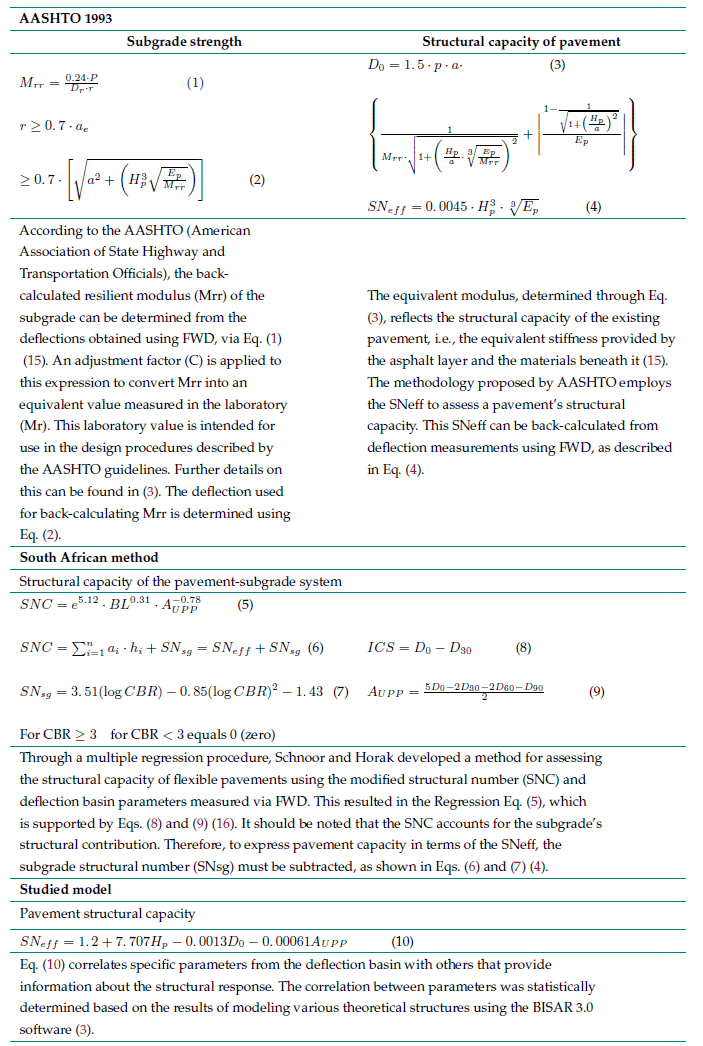
Table III: Structural capacity required
Expression found in the literature
Expression developed in this study
SN
req
= 0. 05716(log N - 2. 32 log Mr +9.07 6 05)2.36777 (11)
SNreq = 12. 547 • Mr
-0.6567 N0.0238-ln Mr+0.0685 (12)
Eq. (11) corresponds to a study on structural capacity conducted by the Virginia Transportation Research Council (VTRC) (17).
Using curve fitting methods, an expression was developed which relates SNreq to the design parameters of the method. This is presented in Eq. (12).
2.2. Mechanistic approach
This approach utilizes pavement mechanics to determine the relationship between the cause of loading (traffic loads) and the structural response, which is characterized by stress states (stresses, deformations, and deflections). The radial tensile strain in the base of the asphalt pavement (εrca)) and the vertical compressive strain in the subgrade (εzsr)) are the parameters considered in estimating structural and functional failure repetitions, respectively.
2.2.1. In-service pavement loadings
Pavement service deformations are calculated using computer programs that simulate stress states through multilayer elastic systems. In this study, the BISAR 3.0 software was employed to calculate the control parameters involved in the mechanistic method (εrca, εzsr), which are associated with fatigue and rutting deterioration 18. To calculate these parameters, regression expressions were also tested in order to predict the structural response based on certain deflection basin parameters obtained via FWD (Table IV).
2.2.2. Allowable pavement loads
In-service loads are estimated employing the transfer functions and correlation models presented in Table V.
Table IV: Loadings calculated using regression expressions

Table V: Loads calculated by regression expressions

3. Indices for the structural condition and remaining service life of pavement
Pavement condition is estimated with the indices presented in Table VI.
4. Results
Fig. 1 presents the correlation results for the different models studied within the mechanistic and empirical approaches. In addition, it shows how the selected structural indices correlate (IVRF/IRVA vs. SCI) depending on the method taken as a reference.
Table VI: Indices for the condition and remaining service life of pavement
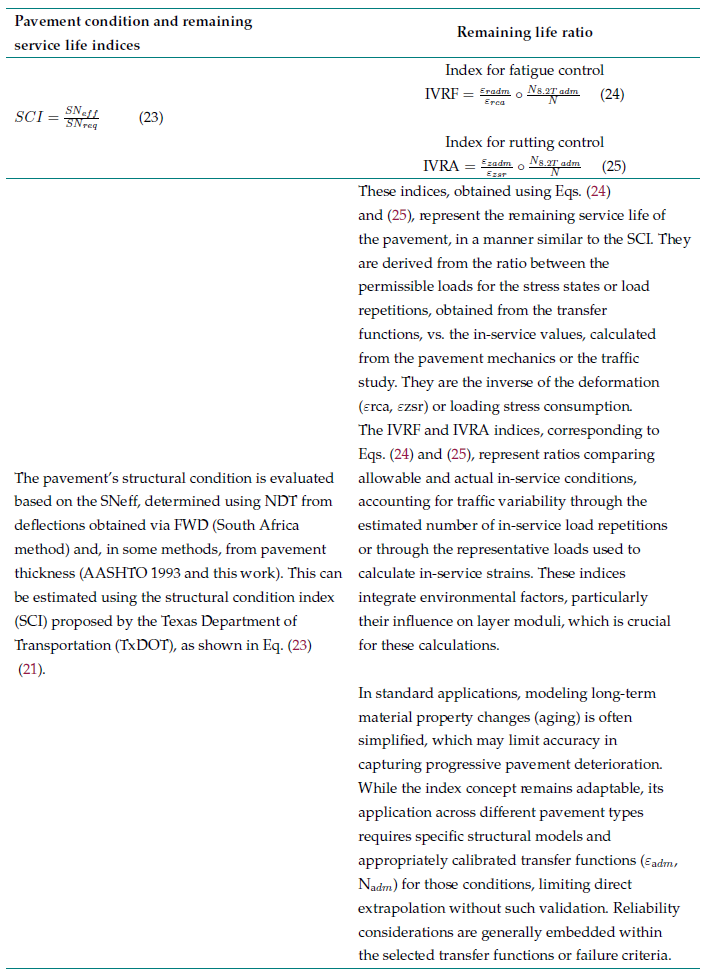
Figure 1: Coefficient of determination for the different models under study
Fig. 2 demonstrates how our model strongly predicts the radial tensile deformation at the base of the asphalt layer (R2=78.5 %). However, the fit is less accurate with the vertical compressive deformation in the subgrade, and the relationship between parameters is moderate (R2=55.0%). A similar trend is observed in the literature-reported model and the control parameters for fatigue and rutting, with R2 values of 79.4 and 19.3 %. Both models, the one consulted and the one developed, predict the radial deformation of the asphalt layer in the same way (R2=99.9 %). However, for the vertical deformation of the subgrade, the relationship is not as strong, and each model estimates the behavior of this parameter differently (R2=63.7%) (Fig. 3).
Figure 2: Relationship between erca and ezsr in the studied models
Figure 3: Relationship between erca and ezsr, as determined in this study and the literature-reported model
To assess the structural capacity of the pavement, the AASHTO 93 method was used as reference due to its recognized international acceptance, extensive application, and proven reliability in the local context. As illustrated in Fig. 4, the AASHTO SNeff exhibits a strong relationship with the predictions obtained with the study's proposed methods and the South Africa approach, with R2 = 95,2 and 93,8 %, respectively. Similarly, a strong relationship is observed when determining the SNeff using our model and the South Africa method (R2=69.7 %).
Figure 4: Relationship between the SNeff values determined through the different methods under study
To calculate the SCI, an expression was developed for determining the SNreq. The derived expression exhibits a strong correlation with an existing model in the literature (R2=95.2%). Fig. 5 illustrates these relationships. Given the strong fit between our model, the literature-based model, and the general AASHTO equation, the SNreq parameter can be accurately predicted.
Figure 5: Relationship between the SNreq values determined using our model and the literature-reported approach
The methods selected as the foundation for this study are among the most rigorous in their calculations, particularly in estimating the remaining service life of pavement based on the relationship between the admissible loads (computed using transfer functions) and the service life (determined via BISAR 3,0). Additionally, as discussed above, the AASHTO 93 method was chosen as a reference framework due to its wide recognition, high acceptance, and extensive validation in the local context. As illustrated in Figs. 6 and 7 a strong correlation is observed between the structural conditions estimated for both the mechanistic and empirical approaches by means of the defined indices (IVRF/IVRA and SCI). These approaches consistently indicate whether pavement reinforcement is required, helping to identify structural deficiencies and mitigate pavement failure risks caused by fatigue and rutting due to repeated traffic loads.
Figure 6: Relationship between IVRF (BISAR 3.0) and SCI, as determined through the methods under study
Similarly, Figs. 6 and 7 illustrate the SCI obtained with both models, showing a strong relationship with the IVRF/IVRA indices. This relationship is slightly stronger with the SCI obtained from the South Africa SNeff model. This behavior indicates that the structural condition of the pavement can be adequately predicted by applying any of the models.
Figure 7: Relationship between IVRA (BISAR 3.0) and SCI, as determined through the methods under study
During this research, alternative methods were tested in which the structural condition is estimated exclusively based on deflection basin parameters, without relying on thickness values obtained from geotechnical or georadar exploration. These techniques include correlation equations to predict εrca and εzsr (mechanistic approach) and the South Africa method (empirical approach). As illustrated in Fig. 8, the relationship between SCI and IVRF in both methods is strong, confirming that a preliminary diagnosis of the pavement can be conducted by monitoring its structural condition and remaining service life. This eliminates the need for invasive testing, making these methods particularly useful for network-level pavement studies. Alternatively, this study proposes estimating the remaining service life by relating the permissible traffic loads (calculated based on the ICS and IDB layer indices) to the traffic study values. The correlation between the IVRF/IVRA and SCI determined through the AASHTO and South Africa methods indicates remarkable consistency. Fig. 9 illustrates the correlation results obtained with the South Africa method. The application of NDT methods can effectively aid in assessing pavement condition in terms of both structural capacity and remaining service life.
5. Discussion
In this study, the application of newly developed models for the structural assessment of pavement was tested while following the same approach and resolution principles as the techniques established in the literature. The results of the proposed expressions for evaluating structural parameters demonstrated strong alignment with findings from previously consulted methods, including correlation equations for predicting the radial tensile strain and the vertical compressive strain (mechanistic approach) as well as the structural number (empirical approach).
Figure 8: Relationship between IVRF/IVRA (correlation equations) and SCI, as determined with the
Figure 9: Relationship between IVRF/IVRA (traffic) and SCI, as determined using the South Africa method
In the specialized literature, (21) conducted a study on the structural condition index, concluding that it correlates strongly with the pavement's remaining service life as a function of fatigue and rutting.
This study successfully validated this relationship for the evaluated in-service pavement sections, which consisted of asphalt concrete wearing courses supported by untreated granular materials.
It is critical to note that these findings apply specifically to the flexible pavement structures evaluated in this study, i.e., asphalt concrete layers over untreated granular materials, supported by various subgrade types. The formulations presented are based on traditional design methodologies developed under specific loading and environmental conditions. Therefore, direct application in significantly different contexts - such as varied climatic conditions, traffic loads, or pavement structures incorporating treated bases - requires careful consideration and likely adjustments through local calibration. This calibration should address structural layer coefficients, drainage coefficients, and reliability levels in order to ensure accurate predictions and facilitate adaptation to similar scenarios.
For network-level pavement assessments, the South Africa method is strongly recommended, as it demonstrates high accuracy in predicting the AASHTO SN. A key advantage of this method is its exclusive reliance on parameters derived from FWD deflection bowl measurements, thereby eliminating the need for thickness data. Unlike the current study, which developed models using theoretical structural frameworks, the South Africa method was formulated using field thickness data and FWD deflection bowl analyses. Consequently, a significant limitation of this study is the lack of model validation using real-world in-service pavement data.
There are several alternative, simple-to-use methods for estimating structural capacity and the remaining service life of pavement based solely on FWD data, without requiring thickness measurements. These approaches eliminate the costs and challenges associated with geotechnical exploration or georadar surveys while maintaining strong correlations with traditional rigorous methods typically applied at the project level. Furthermore, the indices employed in this study exhibit a good mutual correlation, thus supporting structural deficiency detection and collectively indicating whether reinforcement is required to meet structural and remaining life expectations.
References
7. Author contributions
License
Copyright (c) 2025 Edwin Antonio Guzmán Suárez, Diego Fernando Gualdrón Alfonso, Jorge Andrés Sarmiento-Rojas

This work is licensed under a Creative Commons Attribution-NonCommercial-ShareAlike 4.0 International License.
From the edition of the V23N3 of year 2018 forward, the Creative Commons License "Attribution-Non-Commercial - No Derivative Works " is changed to the following:
Attribution - Non-Commercial - Share the same: this license allows others to distribute, remix, retouch, and create from your work in a non-commercial way, as long as they give you credit and license their new creations under the same conditions.





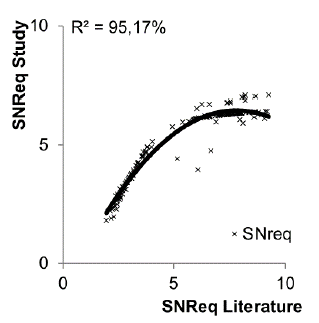







2.jpg)










